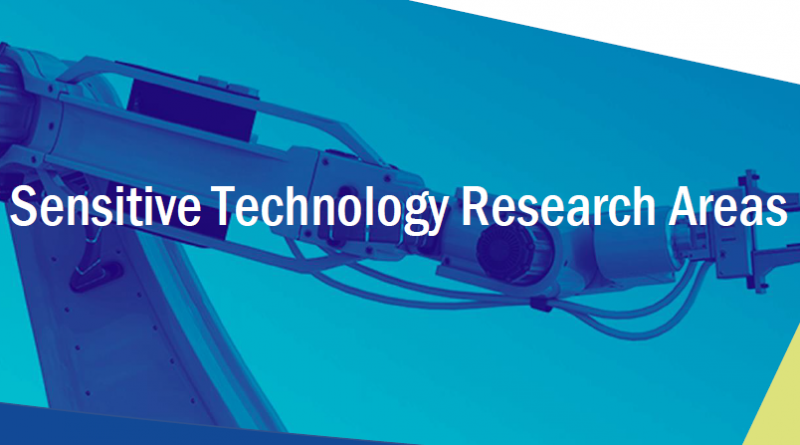Canada’s Sensitive Technology Research Areas
5. Advanced Weapons
Emerging or improved weapons used by military, and in some instances law enforcement, for defence and national security purposes. Advancements in materials, manufacturing, propulsion, energy and other technologies have brought weapons like directed energy weapons and hypersonic weapons closer to reality, while nanotechnology, synthetic biology, artificial intelligence and sensing technologies, among others, have provided enhancements to existing weapons, such as biological/chemical weapons and autonomous weapons.
6. Aerospace, Space and Satellite Technology
Aerospace technology refers to the technology that enables the design, production, testing, operation and maintenance of aircraft, spacecraft and their respective components, as well as other aeronautics. Space and satellite technology refers to technologies that enable travel, research and exploration in space, as well as weather-tracking, advanced PNT, communications, remote sensing and other capabilities using satellites and other space-based assets.
Advanced wind tunnels
Technological advancements in systems related to wind tunnel infrastructure. Existing facilities are used to simulate various flight conditions and speeds ranging from subsonic, transonic, supersonic and hypersonic.
On-orbit servicing, assembly and manufacturing systems
Systems and equipment that are used for space-based servicing, assembly and manufacturing. On-orbit servicing, assembly and manufacturing systems can be used to optimize space logistics, increase efficiencies, mitigate debris threats and to modernize space asset capabilities.
Payloads
Lower cost satellite payloads with increased performance that can meet the needs of various markets. This will require several technology improvements, such as light weight apertures, antennas, panels, transceivers, control actuators, optical/infrared sensor and multi-spectral imagers, to meet the growing demand and ever-increasing technical requirements.
Propulsion technologies
Components and systems that produce a powerful thrust to push an object forward, which is essential to launching aircraft, spacecraft, rockets or missiles. Innovations could range from new designs or advanced materials to enable improved performance, speed, energy-efficiency and other enhanced properties, as well as reduced aircraft production times and emissions. Examples include: electrified aircraft propulsion, solar electric propulsion, pulse detonation engines, nuclear thermal propulsion systems, nuclear pulse propulsion systems and nuclear electric propulsion systems, among others.
Satellites
Artificial or human-made, including (semi-)autonomous, objects placed into orbit. Depending on their specific function, satellites typically consist of an antenna, radio communications system, a power source and a computer, but their exact composition may vary. Continued developments have led to smaller satellites that are less costly to manufacture and deploy compared to large satellites, resulting in faster development times and increased accessibility to space. Examples include: remote sensing and communications satellites.
Space-based positioning, navigation and timing technology
Global Navigation Satellite System (GNSS)-based satellites and technologies that will improve the accuracy, agility and resilience of GNSS and the Global Positioning System (GPS).
Space stations
Space-based facility that can act as an orbital outpost while having the ability to support extended human operations. Space stations can be used as a hub to support other space-based activities including assembly, manufacturing, research, experimentations, training, space vehicle docking and storage. Examples of innovations in space stations could include the ability to extend further out into space or enhanced life support systems that can be used to prolong human missions.
Zero-emission/fuel aircraft
Aircraft powered by energy sources that do not emit polluting emissions that disrupt the environment or do not require fuel to fly. While still in early stages, these advances in powering aircraft could support cleaner air travel, as well as enable flight over greater distances and to remote areas without the need for refueling (for zero-fuel aircraft).
7. Artificial Intelligence and Big Data Technology
Artificial intelligence (AI) is a broad field encompassing the science of making computers behave in a manner that simulates human behaviour/intelligence using data and algorithms. Big data refers to information and data that is large and complex in volume, velocity and variety, and as such, requires specialized tools, techniques and technologies to process, analyze and visualize it. AI and big data technology may be considered cross-cutting given how important they are in enabling developments in other technology areas, including biotechnology, advanced materials and manufacturing, robotics and autonomous systems and others.
AI chipsets
Custom-designed chips meant to process large amounts of data and information that enable algorithms to perform calculations more efficiently, simultaneously and using less energy than general-purpose chips. AI chips have unique design features specialized for AI, which may make them more cost-effective to use for AI development.
Computer vision
Field of AI that allows computers to see and extract meaning from the content of digital images such as photos and videos. Examples of computer vision techniques include: image classification, object detection, depth perception and others.
Data science and big data technology
Enables the autonomous or semi-autonomous analysis of data, namely large and/or complex sets of data when it comes to big data technology. It also includes the extraction or generation of deeper insights, predictions or recommendations to inform decision-making. Examples include: AI-enabled data analytics, big data technology (i.e. data warehouse, data mining, data correlation) and predictive analytics.
Digital twin technology
Virtual representations of physical objects or systems that combine real-time sensor data, big data processing and artificial intelligence (namely machine learning) to create an interactive model and predict the object or system’s future behaviour or performance. Advancements in digital twin technology could enable the growth and integration of an immersive digital experience (e.g. the metaverse) into daily life.
Machine learning (ML)
Branch of AI where computer programs are trained using algorithms and data to improve their decisions when introduced to a new set of data without necessarily being programmed to do so. Types of ML include: deep learning, evolutionary computation and neural networks.
Natural language processing
An area of AI that allows computers to process and make sense of, or ‘translate’, natural human language using speech and audio recognition to identify, analyze and interpret human voices and other types of audio. Examples include: syntactic and semantic analysis, tokenization, text classification and others, which enable capabilities like virtual assistants, chatbots, machine translation, predictive text, sentiment analysis and automatic summarization.





